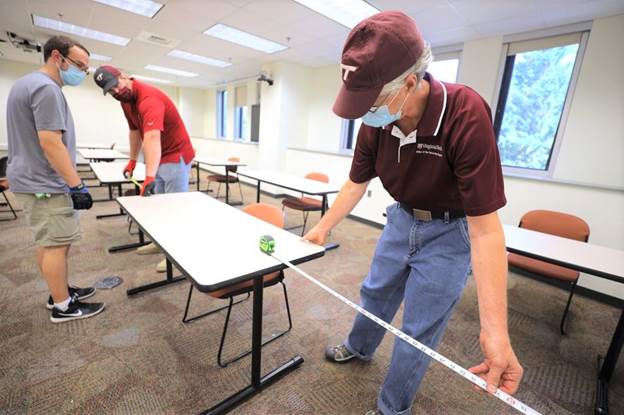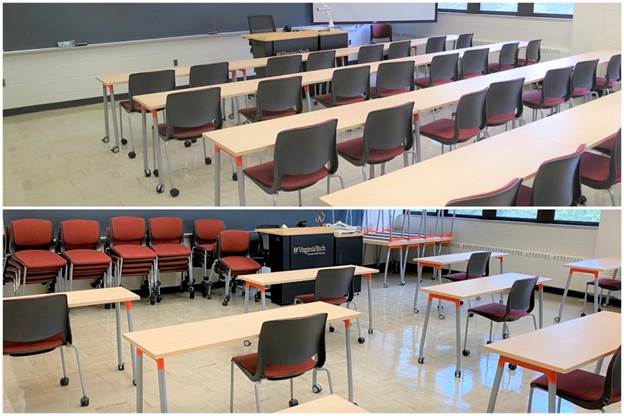
Gary Costello (right), associate registrar for classroom scheduling and governance at Virginia Tech, measures 6-feet distance between desks in a campus classroom. Costello and other university employees are working to reconfigure classrooms throughout ca
The campus spaces where Hokies learn will look a little different this fall.
Classrooms will have fewer desks and chairs, situated 6 feet apart.
Students will wear masks and in some cases, attend class on a rotating basis.
Faculty will teach behind face shields.
COVID-19 is changing the look of classrooms. And with in-person and virtual classes set to begin Aug. 24 at Virginia Tech, the university is working to redesign all classrooms and lab spaces to adhere to public health and safety guidelines set by the Virginia Department of Health.
Take the newly configured room 244 in Wallace Hall. The desks, which are 18-inch by 60-inch tables with rolling legs, are situated 6 feet apart, rather than lined up in rows side-by-side. The desks form a honeycomb shape throughout the room.
Before COVID-19, the classroom held 20 desks with two chairs each. Now there are 12 desks, and each has only one chair.
The capacity of most Virginia Tech classrooms has been reduced by about 75 percent, with a cap at 49 students.
“It’s a pretty tremendous impact,” said Rick Sparks, university registrar, whose office is leading the layout and other changes to the approximately 196 general assignment classrooms across campus. Individual departments maintain other classrooms.
The registrar’s office has posted guidelines for classroom design on its website.

The top photo is Wallace Hall 244 before COVID-19. The bottom photo is Wallace Hall 244 after COVID-19 with physical distancing guidelines. Photos by Ray Meese for Virginia Tech and by Virginia Tech Classroom Audio Visual Services.
Earlier this week, Gary Costello, associate registrar for classroom scheduling and governance, held a long tape measure in the middle of each desk, marking a 6-foot distance to the neighboring desk and with three helpers, moving the furniture accordingly. The 6-foot distance is based on measuring students at a nose-to-nose level, Sparks said.
Before these classroom changes began, Virginia Tech gathered insight from other state universities and its own faculty on how to safely map out rooms.
In some classrooms, spots for desks are marked with taped X’s on the floor. There is tape in other areas of the rooms to indicate where furniture should be placed, if moved.
“When a student walks into the room, they don’t have to question ‘where do I sit?'” Sparks said.
All leftover furniture, which totals about 6,100 pieces, will be stored in an off-campus facility, he said. The university is exploring different storage locations.
While in class, faculty will wear face shields, and students are required to wear face coverings or masks indoors. Hand sanitizer stations will be mounted on walls outside of classrooms.
Classrooms will be cleaned overnight. Also, the university is looking into using a microbial cleaning solution on desks and other surfaces that kills bacteria for up to three months, said Anthony Watson, director of buildings and grounds for Virginia Tech.
Even so, “the key to making all of this work is wearing a mask,” Sparks said.

